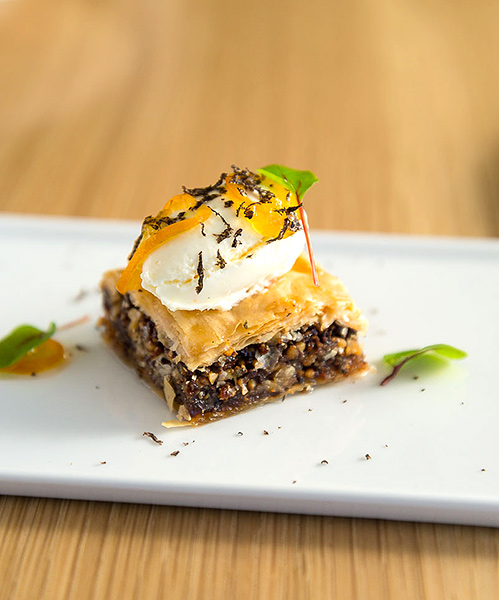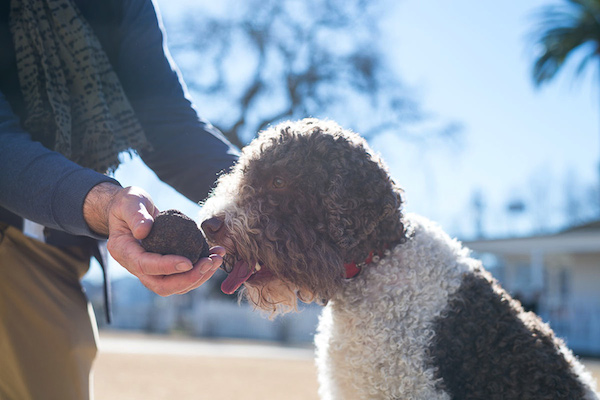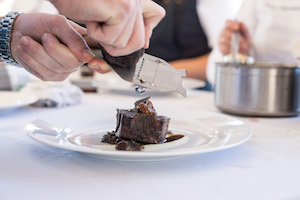As the black winter truffle harvesting season winds down this month, those of us who partake in the earthy gems have reason to celebrate. Soon — within the next two years — it seems we will have a viable local source for this famous fungus.
For this development, thanks go to the Bay Area–based American Truffle Company (ATC), whose chief scientist, Paul Thomas (also lead researcher and managing director of Mycorrhizal Systems Ltd., in London), has developed a way to cultivate the two most valuable black European varieties, Périgord (aka black diamonds) and Burgundy, through a technique considered one of the most technologically advanced, thorough and scientific methods seen anywhere in the world.
Truffles are a kind of underground mushroom that grow on the roots of particular host trees — especially oaks and filberts. There are hundreds of species of truffles, but the fruiting body of some, most notably the European black Périgord truffles (Tuber melanosporum), harvested in the winter, and Burgundy truffles (Tuber aestivum/uncinatum), harvested in the summer, are highly prized by top chefs and connoisseurs around the world for their exquisite flavor.
The demand for these black truffles far exceeds supply, and they command remarkably high prices (the black Périgord, for example, can fetch $1,000-plus a pound). Unlike the white truffles of Italy, which have eluded cultivation efforts, European black truffles can and have been cultivated for decades — perhaps centuries. Their production has occurred almost exclusively in Europe, predominately France, followed by Spain and Italy, with small amounts originating in Slovenia, Croatia and Australia. But now ATC is cultivating black truffles in North America, where the wine growing regions of California offer particularly suitable climates and soils and experienced growers. 
“Growing black truffles can be seven to 10 times more profitable than growing grapes,” says Robert Chang, partner and managing director of ATC, who bases his calculations on data per acre for chardonnay grapes and black truffles in full production. According to Chang, truffles yield a profit of roughly $30,000–$40,000 per acre, compared to about $3,600–$5,000 per acre for grapes. This impressive difference stems from the much higher revenue per acre from truffles and considerably lower labor and maintenance costs. “Furthermore,” says Chang, “truffle orchards continue to produce for 40 to 80 years, whereas grapevines often decline in productivity and must be replaced every few decades.”
These compelling economics explain why in France it is common for growers to replace low-producing vines with truffle-inoculated trees. And the timing couldn’t be better for California wine growers as they seek ways to diversify their crops, which is why both Napa and Sonoma county farm bureaus have hosted several ATC truffle cultivation workshops. Additionally, ATC is working with Napa Flood Control to create incentives for growers to ecologically manage properties in the Napa River’s riparian zone by reforesting with truffle-inoculated native oaks. This practice would stabilize soils and dramatically reduce erosion and sediment runoff (caused by years of agricultural activity), while providing a viable crop that complements both the wine and the food industries.
ATC also produces the annual Napa Truffle Festival, showcasing the venerated black winter Périgord truffle while bringing together leading truffle cultivation experts, scientists and foragers and internationally renowned Michelin-starred chefs. The festival weekend offers a variety of activities, including seminars on truffle cultivation and cuisine, cooking demos, winery truffle lunches (each year hosted by two different wineries), a wild mushroom forage, truffle dog training discussions and demos, a truffle orchard tour, a truffles-and-wine dinner at La Toque, and one big marketplace at Oxbow Public Market.
The truffle orchard tour takes place at Robert Sinskey Vineyards, where the area’s first truffle orchard was planted. The vineyard farms almost 200 acres of vines organically and biodynamically. Biodiversity is an important aspect of this model of farming, which entails planting hedgerows and cover crops, as well as initiating active restoration and maintenance of wild areas. Instead of herbicide sprays, the vineyard employs sheep to “mow” the cover crops during the winter. Since the vineyard owners were planning to hold some land in reserve for the sheep, they decided to plant a “forest” where the sheep can graze while cultivating truffles below.
“It was just an extension of our ‘perfect circle’ concept of farming where everything contributes and feeds into other farm processes,’ proprietor/vintner Rob Sinskey says. “Also, it fits well with the stylistic philosophy of our wines. My wife, Maria Helm Sinskey, is a chef and cookbook author who uses ingredients from our culinary gardens, bees and animals. It’s a romantic notion that we may be able to produce our own truffles as well — and there is nothing better than pinot noir and truffles.”
Moving forward, ATC and its grower/partners have embraced a mission to bring the rare and prized fungi to the forefront of local farming, hence to the kitchens of passionate chefs and the tables of hungry diners. “No ingredient in the kitchen has mesmerized me like the truffle,” says chef Ken Frank of La Toque, who is also host chef for the Napa Truffle Festival. “Foremost, you must start with the very best fresh truffles in season and use them quickly.”
To learn more about truffle cultivation, visit americantruffle.com. The fifth annual Napa Truffle Festival takes place next year, January 17–19, napatrufflefestival.com.
Truffle Hunters: Dogs vs. Pigs
 The most significant advantage to truffle hunting with dogs over the once-traditional pigs is that dogs don’t eat them, as do the female pigs, who seek out the truffles for their irresistible pheromones, which are similar to those of the male pig. Also, a friendly canine makes for a great companion on the hunt and, unlike a pig, is generally eager to jump into the backseat of a car. Here in the burgeoning American truffle cultivation world, the foraging dogs are commonly German shepherds, Labradors, golden retrievers, Belgian Malinois and other hunting breeds. In Italy though, site of some of the most famed and prodigious truffle and wild mushroom growing areas, the official Italian hunting dogs are lagotto romagnolos, or “lake dog from Romagna.” These dogs hunt for “black diamonds” and are worth their weight in gold, fetching prices as high as $13,000. Canine scent detection training specifically for the domestic truffle industry is the specialty of master dog trainer Alana McGee, of Toil & Truffle and Truffle Dog Company, who presents truffle dog training sessions and demonstrations during the festival.
The most significant advantage to truffle hunting with dogs over the once-traditional pigs is that dogs don’t eat them, as do the female pigs, who seek out the truffles for their irresistible pheromones, which are similar to those of the male pig. Also, a friendly canine makes for a great companion on the hunt and, unlike a pig, is generally eager to jump into the backseat of a car. Here in the burgeoning American truffle cultivation world, the foraging dogs are commonly German shepherds, Labradors, golden retrievers, Belgian Malinois and other hunting breeds. In Italy though, site of some of the most famed and prodigious truffle and wild mushroom growing areas, the official Italian hunting dogs are lagotto romagnolos, or “lake dog from Romagna.” These dogs hunt for “black diamonds” and are worth their weight in gold, fetching prices as high as $13,000. Canine scent detection training specifically for the domestic truffle industry is the specialty of master dog trainer Alana McGee, of Toil & Truffle and Truffle Dog Company, who presents truffle dog training sessions and demonstrations during the festival.


